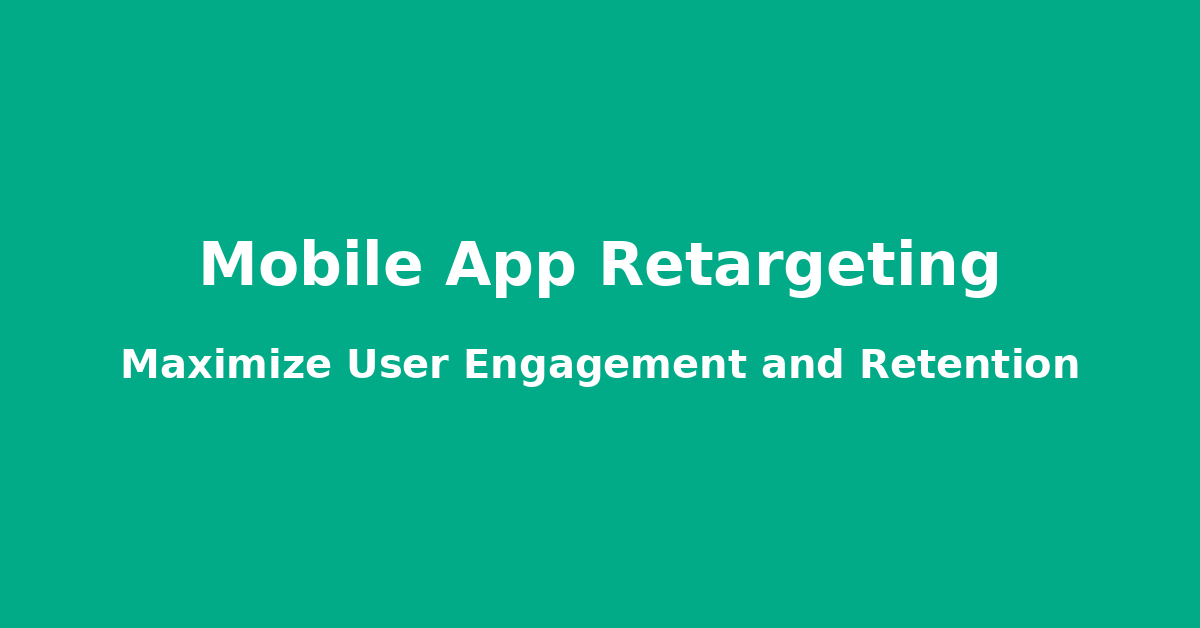This post is a continuation of our series of “Comprehensive Guide to Mobile App Marketing“.
In the competitive landscape of mobile apps, acquiring users is just the beginning. Retaining them and ensuring continued engagement is the real challenge. This is where mobile app retargeting comes into play. Retargeting is a powerful strategy to re-engage users who have downloaded your app but are not as active as you’d like them to be or have stopped using it altogether. In this article, we will explore the best practices for mobile app retargeting to boost user engagement and retention.

Mobile App Retargeting: Strategies to Maximize User Engagement and Retention
What is Mobile App Retargeting?
Mobile app retargeting is a marketing technique used to re-engage users who have interacted with your app but haven’t completed a desired action, such as making a purchase or using a particular feature. It involves displaying targeted ads to these users on various platforms, encouraging them to return to your app.
The Importance of Retargeting
Retargeting is crucial because it costs significantly less to retain an existing user than to acquire a new one. Additionally, users who have already downloaded your app are familiar with your brand, making them more likely to convert. Here are some key reasons why retargeting is important:
Increase Lifetime Value (LTV):
By re-engaging inactive users, you can increase their lifetime value, making your app more profitable.
Reduce Churn Rate:
Retargeting helps in reducing the churn rate by reminding users of the value your app provides.
Boost Engagement:
Engaging users with personalized messages or offers can reignite their interest and encourage them to explore more features of your app.
Enhance User Experience:
By understanding user behavior and preferences, you can offer tailored experiences that meet their needs.
Best Practices for Mobile App Retargeting
To make the most of your retargeting efforts, it’s essential to follow best practices. Here are some strategies to consider:
1. Segment Your Audience
Not all users are the same, and their reasons for inactivity will vary. Segmenting your audience allows you to create more personalized and effective retargeting campaigns. Consider segmenting users based on:
- Inactivity Duration: Users who have been inactive for a week, a month, or more.
- Behavioral Data: Users who have shown interest in specific features or products but did not complete a transaction.
- Demographics: Age, gender, location, and other demographic factors.
2. Use Deep Linking
Deep linking directs users to a specific page or feature within your app, rather than just the home screen. This improves the user experience by taking them directly to the content they’re interested in, increasing the chances of conversion.
Example:
If a user added an item to their cart but didn’t complete the purchase, a deep link can take them directly to their cart with the item ready for checkout.
3. Personalize Your Messages
Personalization is key to effective retargeting. Tailor your messages based on user behavior, preferences, and demographics. Personalized messages show users that you understand their needs and can provide relevant solutions.
Example:
“Hi [User Name], we noticed you left something in your cart. Complete your purchase today and enjoy a 10% discount!”
4. Leverage Push Notifications
Push notifications are a direct way to reach users and bring them back to your app. Ensure your notifications are timely, relevant, and offer value. Overuse can lead to annoyance and increased uninstall rates, so use them judiciously.
Example:
“Your favorite item is back in stock! Check it out now before it’s gone.”
5. Utilize In-App Messages
In-app messages are another effective way to engage users while they’re already using your app. These messages can promote new features, offer discounts, or provide helpful tips, enhancing the user experience.
Example:
“Did you know you can now track your order directly in the app? Tap here to try it out!”
6. Offer Incentives
Incentives such as discounts, exclusive content, or loyalty points can be powerful motivators for users to return to your app. Ensure that the incentives are appealing and relevant to your users.
Example:
“Welcome back! Here’s a 20% discount on your next purchase. Use code: WELCOME20.”
7. Track and Analyze Performance
Constantly monitor the performance of your retargeting campaigns. Use analytics to track key metrics such as click-through rates, conversion rates, and user engagement. This data will help you optimize your campaigns and improve results over time.
Example:
“Campaign A had a 15% conversion rate, while Campaign B had a 10% conversion rate. Focus more on strategies used in Campaign A.”
8. Test and Optimize
A/B testing is essential for understanding what works best for your audience. Test different ad creatives, messages, and incentives to see what resonates most with your users. Continuously optimize based on your findings.
Example:
“Test different headlines: ‘Get 20% Off Now!’ vs. ‘Your Favorite Items Are on Sale!’ and analyze which performs better.”
Retargeting Channels to Consider
Several channels can be utilized for mobile app retargeting. Here are some popular ones:
1. Social Media Platforms
Platforms like Facebook, Instagram, and Twitter offer robust retargeting options. You can create highly targeted ads based on user behavior and interests.
Example:
“Retarget users who visited your app’s checkout page with Facebook ads promoting a limited-time discount.”
2. Google Ads
Google Ads allows you to retarget users across the Google Display Network, including YouTube. This broad reach ensures you can engage users on various platforms they frequently visit.
Example:
“Show ads to users who have watched your app’s promotional video on YouTube but haven’t downloaded the app yet.”
3. In-App Advertising
Partner with other apps to display your retargeting ads within their apps. This can be particularly effective if the partner app has a similar audience to yours.
Example:
“Display retargeting ads in a popular fitness app to re-engage users who downloaded your health tracking app.”
Conclusion
Mobile app retargeting is a crucial strategy for maximizing user engagement and retention. By segmenting your audience, using deep linking, personalizing messages, leveraging push notifications, utilizing in-app messages, offering incentives, tracking performance, and continuously testing and optimizing, you can create effective retargeting campaigns that bring users back to your app.
Remember, the goal is not just to re-engage users but to provide them with value that keeps them coming back. By implementing these best practices, you can build a loyal user base and drive long-term success for your mobile app

Leave a Reply